differential TOYOTA TUNDRA 2023 Owners Manual
[x] Cancel search | Manufacturer: TOYOTA, Model Year: 2023, Model line: TUNDRA, Model: TOYOTA TUNDRA 2023Pages: 616, PDF Size: 11.14 MB
Page 3 of 616
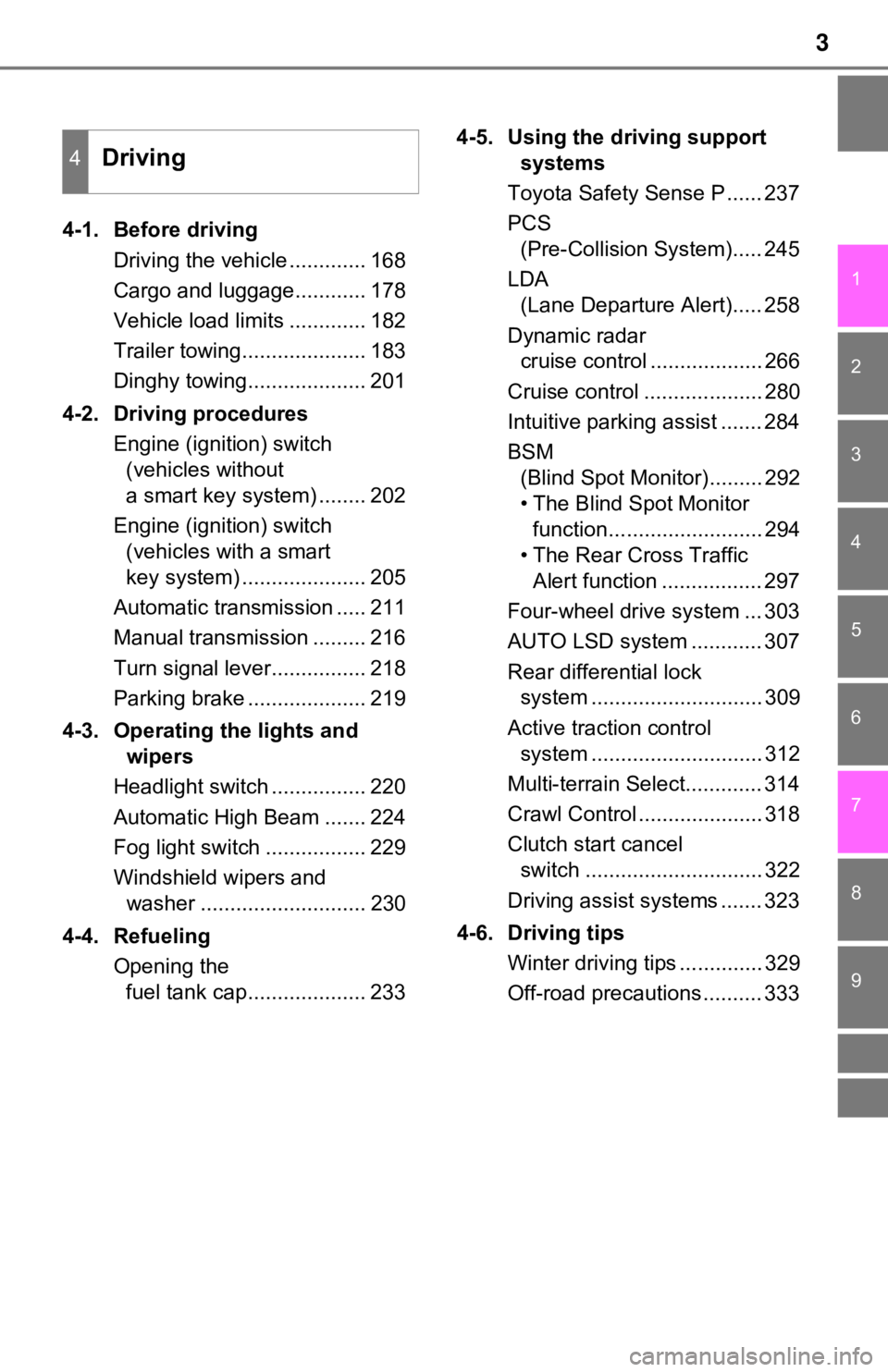
3
1
8 7 5 4
3
2
9
6
4-1. Before drivingDriving the vehicle ............. 168
Cargo and luggage............ 178
Vehicle load limits ............. 182
Trailer towing..................... 183
Dinghy towing.................... 201
4-2. Driving procedures Engine (ignition) switch (vehicles without
a smart key system) ........ 202
Engine (ignition) switch (vehicles with a smart
key system) ..................... 205
Automatic transmission ..... 211
Manual transmission ......... 216
Turn signal lever................ 218
Parking brake .................... 219
4-3. Operating the lights and wipers
Headlight switch ................ 220
Automatic High Beam ....... 224
Fog light switch ................. 229
Windshield wipers and washer ............................ 230
4-4. Refueling Opening the fuel tank cap.................... 233 4-5. Using the driving support
systems
Toyota Safety Sense P ...... 237
PCS (Pre-Collision System)..... 245
LDA (Lane Departure Alert)..... 258
Dynamic radar cruise control ................... 266
Cruise control .................... 280
Intuitive parking assist ....... 284
BSM (Blind Spot Monitor)......... 292
• The Blind Spot Monitor function.......................... 294
• The Rear Cross Traffic Alert function ................. 297
Four-wheel drive system ... 303
AUTO LSD system ............ 307
Rear differential lock system ............................. 309
Active traction control system ............................. 312
Multi-terrain Select............. 314
Crawl Control ..................... 318
Clutch start cancel switch .............................. 322
Driving assist systems ....... 323
4-6. Driving tips Winter driving tips .............. 329
Off-road precautions .......... 333
4Driving
Page 24 of 616
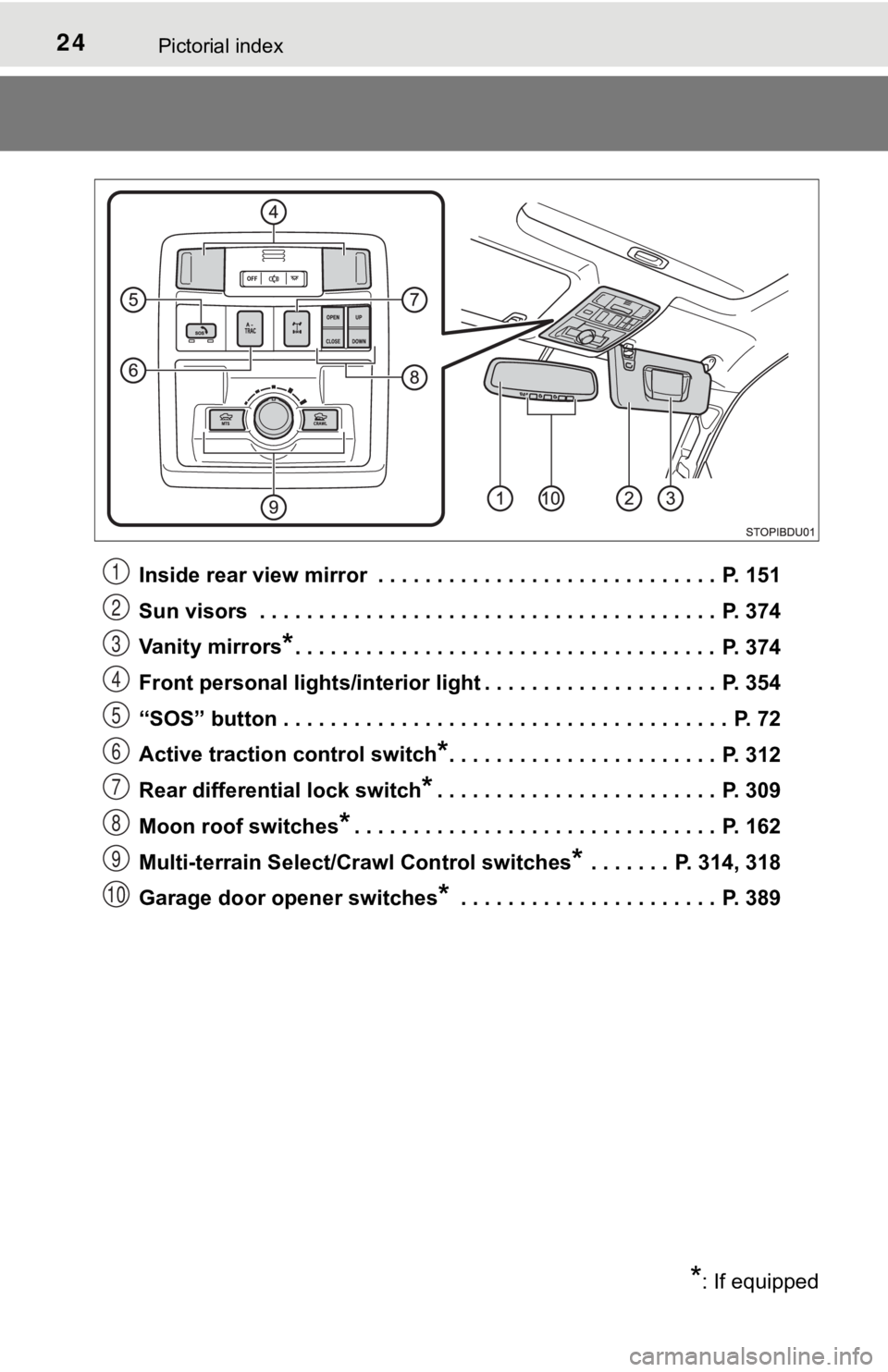
24Pictorial index
Inside rear view mirror . . . . . . . . . . . . . . . . . . . . . . . . . . . . . P. 151
Sun visors . . . . . . . . . . . . . . . . . . . . . . . . . . . . . . . . . . . . . . . P. 374
Vanity mirrors
*. . . . . . . . . . . . . . . . . . . . . . . . . . . . . . . . . . . . P. 374
Front personal lights/interior light . . . . . . . . . . . . . . . . . . . . P. 354
“SOS” button . . . . . . . . . . . . . . . . . . . . . . . . . . . . . . . . . . . . . . P. 72
Active traction control switch
*. . . . . . . . . . . . . . . . . . . . . . . P. 312
Rear differential lock switch
*. . . . . . . . . . . . . . . . . . . . . . . . P. 309
Moon roof switches
*. . . . . . . . . . . . . . . . . . . . . . . . . . . . . . . P. 162
Multi-terrain Select/Crawl Control switches
* . . . . . . . P. 314, 318
Garage door opener switches
* . . . . . . . . . . . . . . . . . . . . . . P. 389
*: If equipped
1
2
3
4
5
6
7
8
9
10
Page 93 of 616
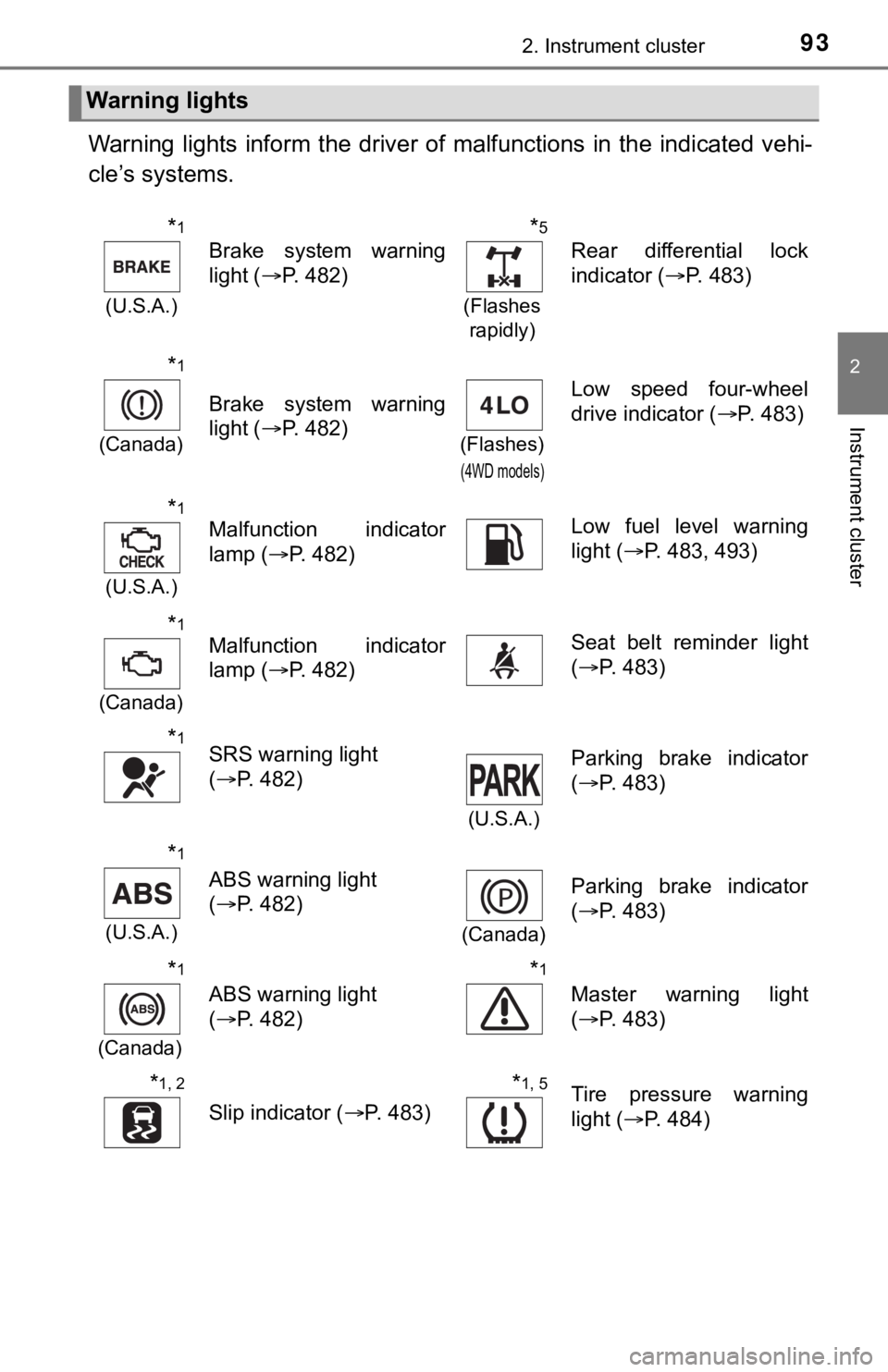
932. Instrument cluster
2
Instrument cluster
Warning lights inform the driver of malfunctions in the indicated vehi-
cle’s systems.
Warning lights
*1
(U.S.A.)
Brake system warning
light ( P. 482)
*5
(Flashes
rapidly)
Rear differential lock
indicator ( P. 483)
*1
(Canada)
Brake system warning
light ( P. 482)
(Flashes)
(4WD models)
Low speed four-wheel
drive indicator ( P. 483)
*1
(U.S.A.)
Malfunction indicator
lamp (P. 482)Low fuel level warning
light (P. 483, 493)
*1
(Canada)
Malfunction indicator
lamp ( P. 482)Seat belt reminder light
(P. 483)
*1SRS warning light
(P. 482)
(U.S.A.)
Parking brake indicator
(P. 483)
*1
(U.S.A.)
ABS warning light
(P. 482)
(Canada)
Parking brake indicator
(P. 483)
*1
(Canada)
ABS warning light
(P. 482)
*1
Master warning light
(P. 483)
*1, 2
Slip indicator ( P. 483)
*1, 5Tire pressure warning
light (P. 484)
Page 95 of 616
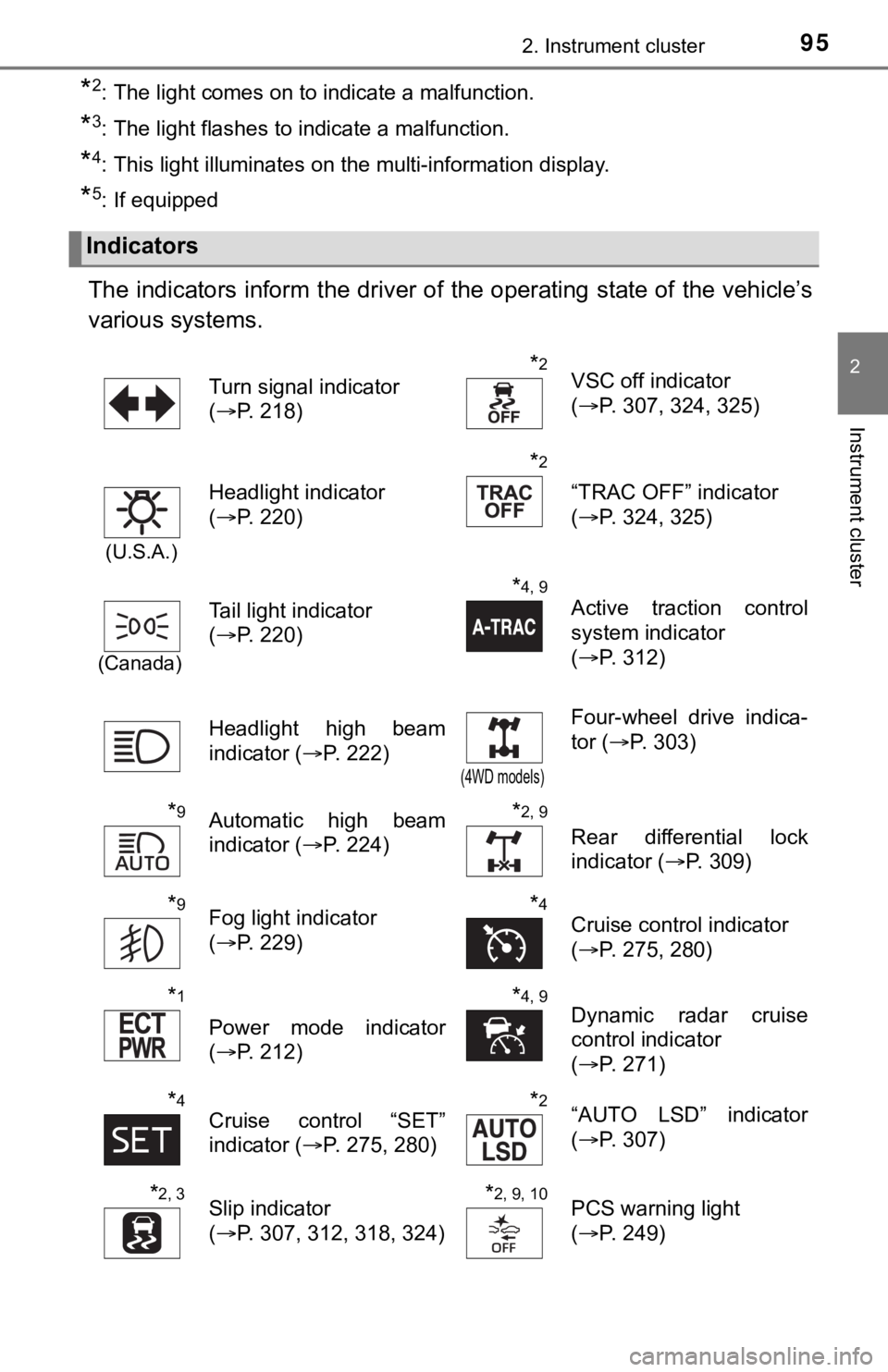
952. Instrument cluster
2
Instrument cluster
*2: The light comes on to indicate a malfunction.
*3: The light flashes to indicate a malfunction.
*4: This light illuminates on the multi-information display.
*5: If equipped
The indicators inform the driver of the operating state of the vehicle’s
various systems.
Indicators
Turn signal indicator
( P. 218)*2VSC off indicator
(P. 307, 324, 325)
(U.S.A.)
Headlight indicator
(P. 220)
*2
“TRAC OFF” indicator
(P. 324, 325)
(Canada)
Tail light indicator
(P. 220)
*4, 9
Active traction control
system indicator
(P. 312)
Headlight high beam
indicator ( P. 222)
(4WD models)
Four-wheel drive indica-
tor (P. 303)
*9Automatic high beam
indicator ( P. 224)*2, 9
Rear differential lock
indicator (P. 309)
*9Fog light indicator
(P. 229)*4Cruise control indicator
(P. 275, 280)
*1
Power mode indicator
(P. 212)
*4, 9Dynamic radar cruise
control indicator
(P. 271)
*4Cruise control “SET”
indicator ( P. 275, 280)*2“AUTO LSD” indicator
(P. 307)
*2, 3Slip indicator
(P. 307, 312, 318, 324)*2, 9, 10PCS warning light
(P. 249)
Page 167 of 616

167
4Driving
4-4. RefuelingOpening the fuel tank cap.................... 233
4-5. Using the driving support systems
Toyota Safety Sense P ..... 237
PCS (Pre-Collision System) .... 245
LDA (Lane Departure Alert) .... 258
Dynamic radar cruise control ............................. 266
Cruise control .................... 280
Intuitive parking assist ....... 284
BSM (Blind Spot Monitor) ........ 292
• T he Blind Spot Monitor
function ......................... 294
• T he Rear Cross Traffic
Alert function ................. 297
Four-wheel drive system ... 303
AUTO LSD system ............ 307 Rear differential lock
system ............................ 309
Active traction control system ............................ 312
Multi-terrain Select ............ 314
Crawl Control .................... 318
Clutch start cancel switch .............................. 322
Driving assist systems ...... 323
4-6. Driving tips Winter driving tips ............. 329
Off-road precautions ......... 333
Page 177 of 616
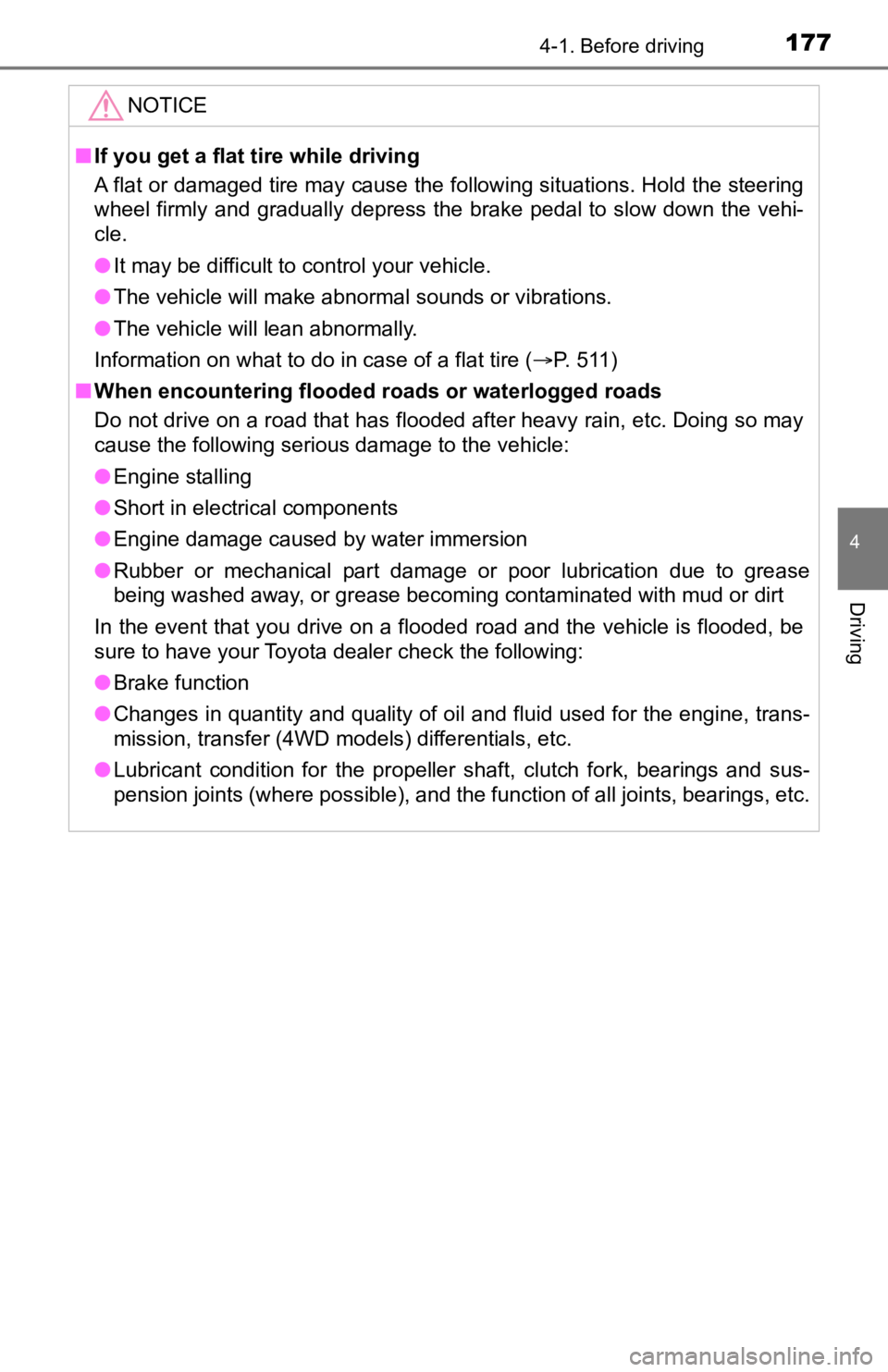
1774-1. Before driving
4
Driving
NOTICE
■If you get a flat tire while driving
A flat or damaged tire may cause the following situations. Hold the steering
wheel firmly and gradually depress the brake pedal to slow down the vehi-
cle.
● It may be difficult to control your vehicle.
● The vehicle will make abnormal sounds or vibrations.
● The vehicle will lean abnormally.
Information on what to do in case of a flat tire ( P. 511)
■ When encountering flooded roads or waterlogged roads
Do not drive on a road that has flooded after heavy rain, etc. Doing so may
cause the following serious damage to the vehicle:
● Engine stalling
● Short in electrical components
● Engine damage caused by water immersion
● Rubber or mechanical part damage or poor lubrication due to grease
being washed away, or grease becoming contaminated with mud or dirt
In the event that you drive on a flooded road and the vehicle is flooded, be
sure to have your Toyota dealer check the following:
● Brake function
● Changes in quantity and quality of oil and fluid used for the engine, trans-
mission, transfer (4WD models) differentials, etc.
● Lubricant condition for the propeller shaft, clutch fork, beari ngs and sus-
pension joints (where possible), and the function of all joints, bearings, etc.
Page 197 of 616

1974-1. Before driving
4
Driving
■When towing a trailer
Disable the following systems, as the systems may not operate p roperly.
● LDA (Lane Departure Alert with Yaw Assist Function) (if equippe d)
( P. 258)
● Dynamic radar cruise control (if equipped) ( P. 266)
● Cruise control (if equipped) ( P. 280)
● BSM (Blind Spot Monitor) (if equipped) ( P. 292)
● Intuitive parking assist (if equipped) ( P. 284)
● RCTA (Rear Cross Traffic Alert) function (if equipped) ( P. 292)
■ Break-in schedule
If your vehicle is new or equipped with any new power train com ponents
(such as an engine, transmission, differential or wheel bearing ), Toyota rec-
ommends that you do not tow a trailer until the vehicle has bee n driven for
over 500 miles (800 km).
After the vehicle has been driven for over 500 miles (800 km), you can start
towing. However, for the next 500 miles (800 km), drive the veh icle at a speed
of less than 50 mph (80 km/h) when towing a trailer, and avoid full throttle
acceleration.
■ Maintenance
●If you tow a trailer, your vehicle will require more frequent m aintenance due
to the additional load. (See “Owner’s Warranty Information Book let” or
“Scheduled Maintenance Guide”/“Owner’s Manual Supplement”.)
● Retighten the fixing bolts of the towing ball and bracket after approximately
600 miles (1000 km) of trailer towing.
Page 309 of 616
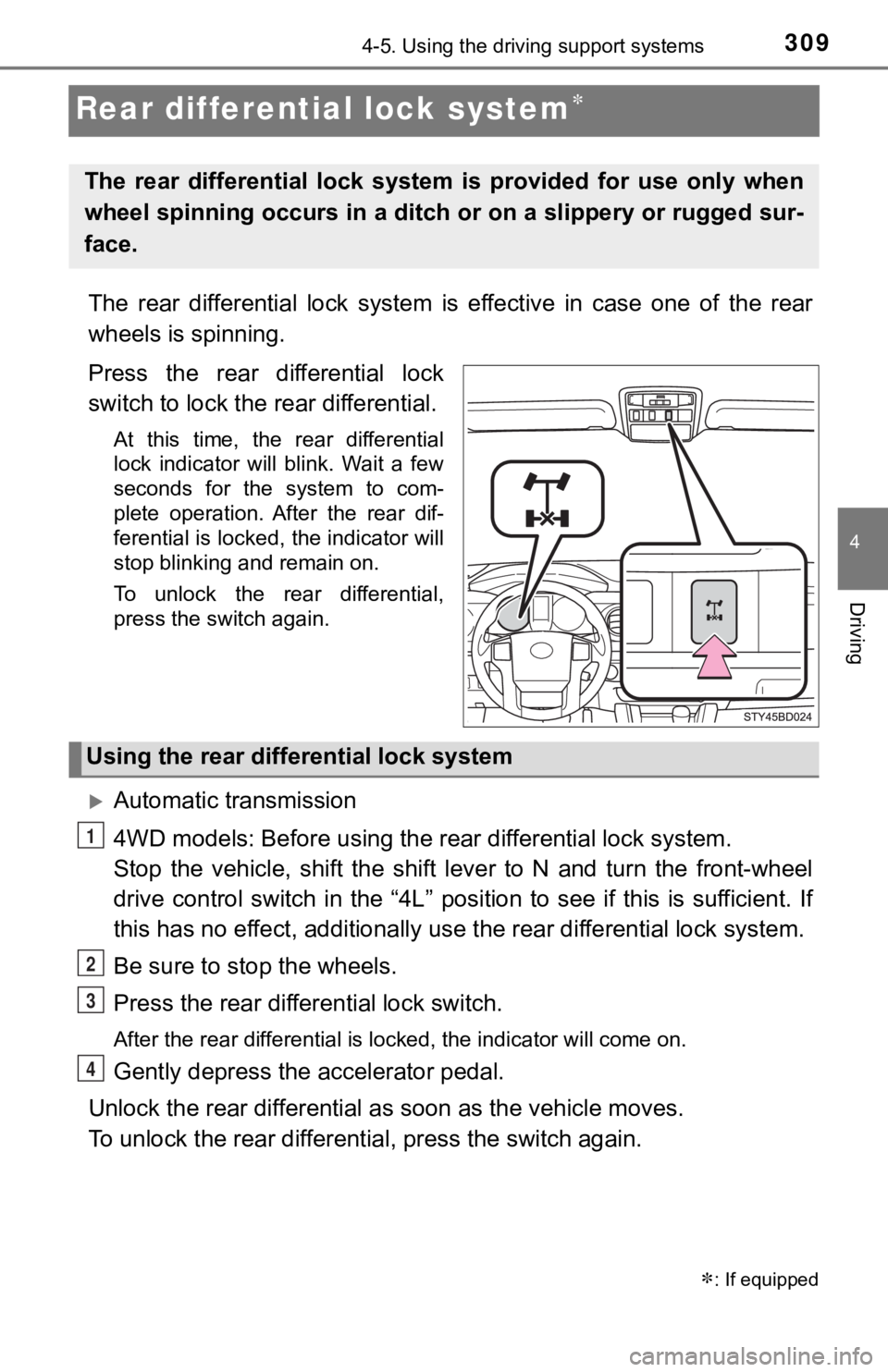
3094-5. Using the driving support systems
4
Driving
Rear differential lock system
The rear differential lock system is effective in case one of the rear
wheels is spinning.
Press the rear differential lock
switch to lock the rear differential.
At this time, the rear differential
lock indicator will blink. Wait a few
seconds for the system to com-
plete operation. After the rear dif-
ferential is locked, the indicator will
stop blinking and remain on.
To unlock the rear differential,
press the switch again.
Automatic transmission
4WD models: Before us ing the rear differential lock system.
Stop the vehicle, shift the shi ft lever to N and turn the front-wheel
drive control switch in the “4L” position to see if this is sufficient. If
this has no effect, additionally use the rear differential lock system.
Be sure to stop the wheels.
Press the rear differential lock switch.
After the rear differential is locked, the indicator will come on.
Gently depress the accelerator pedal.
Unlock the rear differential as soon as the vehicle moves.
To unlock the rear different ial, press the switch again.
: If equipped
The rear differential lock system is provided for use only when
wheel spinning occurs in a ditch or on a slippery or rugged sur -
face.
Using the rear diffe rential lock system
1
2
3
4
Page 310 of 616

3104-5. Using the driving support systems
Manual transmission
Before using the rear differential lock system.
Stop the vehicle or reduce your speed to less than 2 mph (3 km/h ).
Depress the clutch pedal and turn the front-wheel drive control
switch in the “4L” position to see if this is sufficient. If th is has no
effect, additionally use the re ar differential lock system.
Be sure to stop the wheels.
Depress the clutch pedal.
Press the rear differential lock switch.
After the rear differential is locked, the indicator will come on.
Slowly release th e clutch pedal.
Unlock the rear differential as soon as the vehicle moves.
To unlock the rear different ial, press the switch again.
■Locking the rear differential
●When the rear differential is locked, VSC is automatically turn ed off.
(The rear differential lock and VSC off indicators come on.)
● The following systems do not operate when the rear differential is locked. It
is normal operation for the ABS warning light and VSC off indic ator to be on
at this time.
•ABS
• Multi Terrain ABS (if equipped)
• Brake assist system
•VSC
•TRAC
• Pre-Collision System (if equipped)
• Dynamic radar cruise control system (if equipped)
• Cruise control system (if equipped)
• Hill-start assist control (if equipped on 4WD models)
■ The rear differential lock is disengaged when
●Vehicles without a smart key system: When the engine switch is turned to
the “LOCK” position
● Vehicles with a smart key system: When the engine switch is tur ned off
● 4WD models only: Turn the front-wheel drive control switch to “ 2WD” or “4H”
position.
Never forget to turn off the switch after using this feature.
1
2
3
4
5
Page 311 of 616
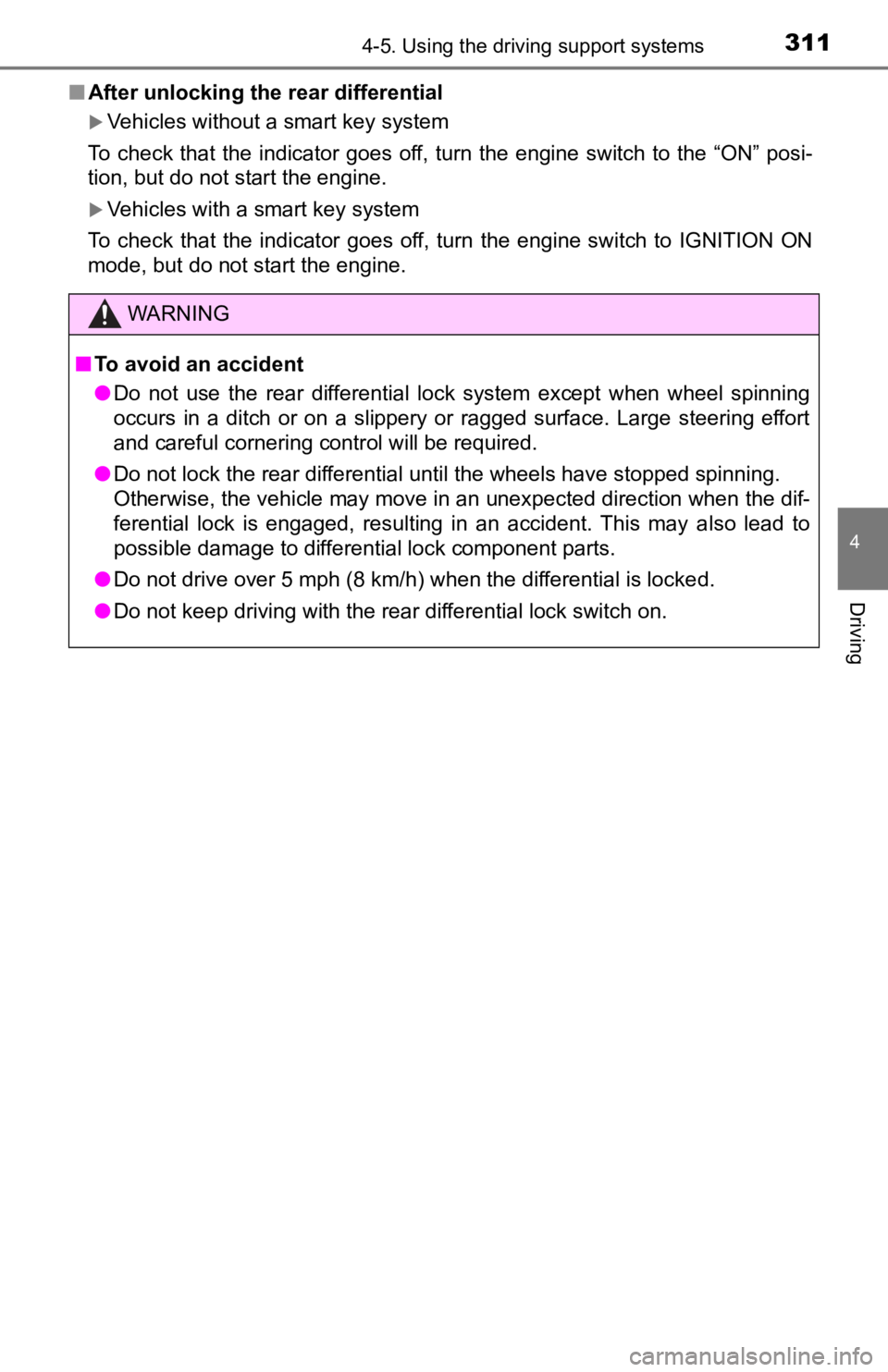
3114-5. Using the driving support systems
4
Driving
■After unlocking the rear differential
Vehicles without a smart key system
To check that the indicator goes off, turn the engine switch to the “ON” posi-
tion, but do not start the engine.
Vehicles with a smart key system
To check that the indicator goes off, turn the engine switch to IGNITION ON
mode, but do not start the engine.
WARNING
■ To avoid an accident
● Do not use the rear differential lock system except when wheel spinning
occurs in a ditch or on a slippery or ragged surface. Large steering effort
and careful cornering control will be required.
● Do not lock the rear differential until the wheels have stopped spinning.
Otherwise, the vehicle may move in an unexpected direction when the dif-
ferential lock is engaged, resulting in an accident. This may also lead to
possible damage to differential lock component parts.
● Do not drive over 5 mph (8 km/h) when the differential is locke d.
● Do not keep driving with the rear differential lock switch on.